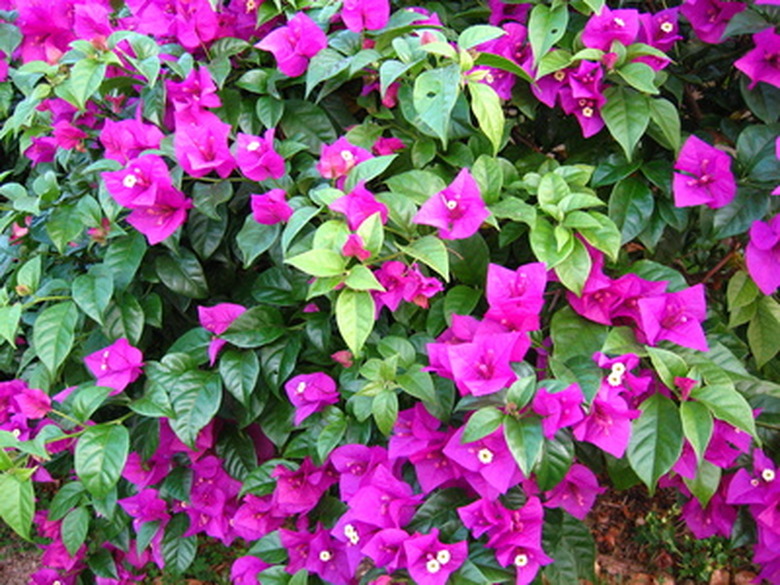Vines & Tall Plants For A Hot Stucco Wall
If you have a stucco wall that gets a lot of sun, many tropical plants will grow successfully in front of it. Vines can climb a trellis or wire mesh placed against it and some types of edibles greatly benefit from the reflected heat of a stucco wall. Because of the additional reflected heat, plants and vines grown in this location may require more water than the same varieties grown elsewhere in your garden.
Bougainvillea
A flowering tropical vine, bougainvillea (Bougainvillea spp.) loves the heat and will happily grow against a hot stucco wall. They are native to the coast of Brazil and are frost-tender. They have red, pink, magenta or even white flowers that are produced in abundance all summer long. Bougainvilleas will thrive in nearly any type of soil, as long as it is fertile and well-drained. It prefers full sun and will produce few, if any, flowers if grown in a shady location. Provide a trellis for them to grow upon or attach a sheet of open-mesh fencing directly to the stucco wall for them to climb. If you withhold a little moisture bougainvilleas will produce more blossoms; however, they may need watering every day if grown in a pot. Feed weekly with water-soluble fertilizer mixed with water at half the strength recommended by the manufacturer. In temperate areas they can be overwintered indoors in a pot, but they won't flower indoors and will most likely go dormant until moved outdoors when frost-free weather arrives in spring.
- If you have a stucco wall that gets a lot of sun, many tropical plants will grow successfully in front of it.
- If you withhold a little moisture bougainvilleas will produce more blossoms; however, they may need watering every day if grown in a pot.
Trumpet Vine
Recently reclassified botanically (according to the University of California Davis Extension), varieties of the trumpet vine are now split between the genera Distictis and Bignonia, although they are all still commonly referred to as the trumpet vine. Growing to a height of 20 to 30 feet, it has evergreen leaves and red, orange-red, yellow, pink, purple, yellow or white flowers. Flowers are about 2 inches in diameter and appear in clusters at the terminal ends of side branches. They are excellent grown against a stucco wall, although they will need a trellis or fence for support. They also grow in partial shade but produce more flowers in full sun. Apply fertilizer sparingly—mix it at half the manufacturer's recommended strength–every two to three weeks during the growing season. Trumpet vines may cease blooming for up to two years if over-fertilized.
- Recently reclassified botanically (according to the University of California Davis Extension), varieties of the trumpet vine are now split between the genera Distictis and Bignonia, although they are all still commonly referred to as the trumpet vine.
- They are excellent grown against a stucco wall, although they will need a trellis or fence for support.
Chile Peppers
A heat-loving garden vegetable, hot chile peppers (Capsicum spp.) can reach heights of 5 feet or more growing in the heat and reflected light of a stucco wall. A short-lived perennial in their native habitat, they often grow even taller in their native tropical climate. Position the plants about 18 to 24 inches out from the surface of the wall, so air can easily circulate around them. This will help guard against fungal diseases. Resist the temptation to over water hot peppers; they produce more fruit if allowed to experience a little drought. Picking the first few peppers on each plant while they are still green will also encourage the plant to produce more fruits. Sweet bell peppers will also grow well against a stucco wall, but the plants will not grow as tall as the hot variety.
- A heat-loving garden vegetable, hot chile peppers (Capsicum spp.)
- Sweet bell peppers will also grow well against a stucco wall, but the plants will not grow as tall as the hot variety.
